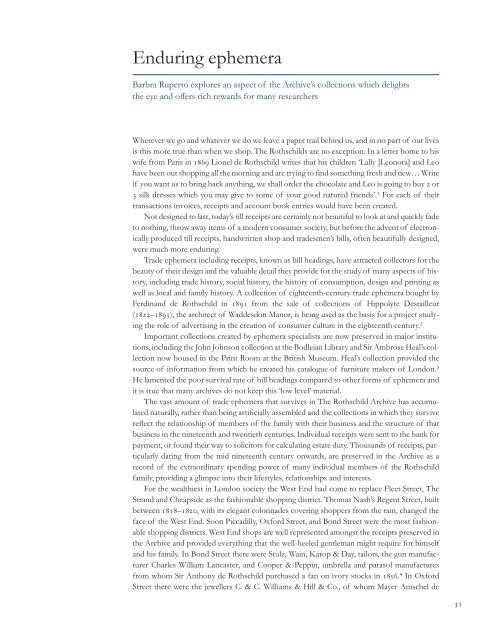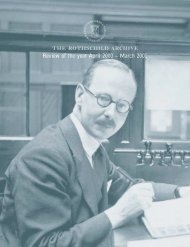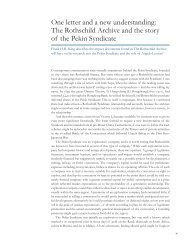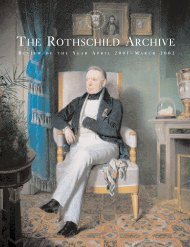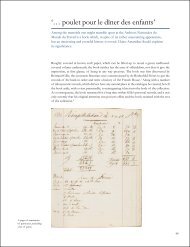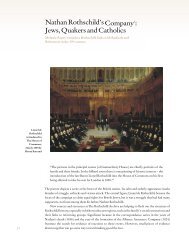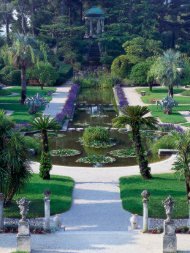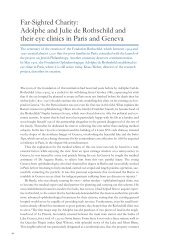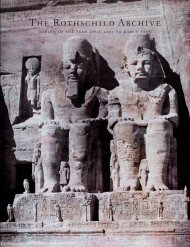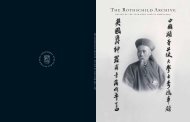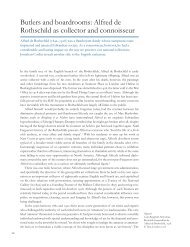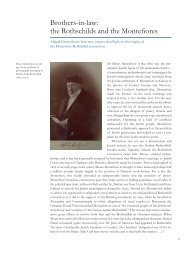Enduring ephemera - The Rothschild Archive.
Enduring ephemera - The Rothschild Archive.
Enduring ephemera - The Rothschild Archive.
Create successful ePaper yourself
Turn your PDF publications into a flip-book with our unique Google optimized e-Paper software.
<strong>Enduring</strong> <strong>ephemera</strong><br />
Barbra Ruperto explores an aspect of the <strong>Archive</strong>’s collections which delights<br />
the eye and offers rich rewards for many researchers<br />
Wherever we go and whatever we do we leave a paper trail behind us, and in no part of our lives<br />
is this more true than when we shop. <strong>The</strong> <strong>Rothschild</strong>s are no exception. In a letter home to his<br />
wife from Paris in 1869 Lionel de <strong>Rothschild</strong> writes that his children ‘Lally [Leonora] and Leo<br />
have been out shopping all the morning and are trying to find something fresh and new… Write<br />
if you want us to bring back anything, we shall order the chocolate and Leo is going to buy 2 or<br />
3 silk dresses which you may give to some of your good natured friends’. ₁ For each of their<br />
transactions invoices, receipts and account book entries would have been created.<br />
Not designed to last, today’s till receipts are certainly not beautiful to look at and quickly fade<br />
to nothing, throw away items of a modern consumer society, but before the advent of electronically<br />
produced till receipts, handwritten shop and tradesmen’s bills, often beautifully designed,<br />
were much more enduring.<br />
Trade <strong>ephemera</strong> including receipts, known as bill headings, have attracted collectors for the<br />
beauty of their design and the valuable detail they provide for the study of many aspects of history,<br />
including trade history, social history, the history of consumption, design and printing as<br />
well as local and family history. A collection of eighteenth-century trade <strong>ephemera</strong> bought by<br />
Ferdinand de <strong>Rothschild</strong> in 1891 from the sale of collections of Hippolyte Destailleur<br />
(1822–1893), the architect of Waddesdon Manor, is being used as the basis for a project studying<br />
the role of advertising in the creation of consumer culture in the eighteenth century.²<br />
Important collections created by <strong>ephemera</strong> specialists are now preserved in major institutions,<br />
including the John Johnson collection at the Bodleian Library and Sir Ambrose Heal’s collection<br />
now housed in the Print Room at the British Museum. Heal’s collection provided the<br />
source of information from which he created his catalogue of furniture makers of London.³<br />
He lamented the poor survival rate of bill headings compared to other forms of <strong>ephemera</strong> and<br />
it is true that many archives do not keep this ‘low level’ material.<br />
<strong>The</strong> vast amount of trade <strong>ephemera</strong> that survives in <strong>The</strong> <strong>Rothschild</strong> <strong>Archive</strong> has accumulated<br />
naturally, rather than being artificially assembled and the collections in which they survive<br />
reflect the relationship of members of the family with their business and the structure of that<br />
business in the nineteenth and twentieth centuries. Individual receipts were sent to the bank for<br />
payment, or found their way to solicitors for calculating estate duty. Thousands of receipts, particularly<br />
dating from the mid nineteenth century onwards, are preserved in the <strong>Archive</strong> as a<br />
record of the extraordinary spending power of many individual members of the <strong>Rothschild</strong><br />
family, providing a glimpse into their lifestyles, relationships and interests.<br />
For the wealthiest in London society the West End had come to replace Fleet Street, <strong>The</strong><br />
Strand and Cheapside as the fashionable shopping district. Thomas Nash’s Regent Street, built<br />
between 1818–1820, with its elegant colonnades covering shoppers from the rain, changed the<br />
face of the West End. Soon Piccadilly, Oxford Street, and Bond Street were the most fashionable<br />
shopping districts. West End shops are well represented amongst the receipts preserved in<br />
the <strong>Archive</strong> and provided everything that the well-heeled gentleman might require for himself<br />
and his family. In Bond Street there were Stulz, Wain, Karop & Day, tailors, the gun manufacturer<br />
Charles William Lancaster, and Cooper & Peppin, umbrella and parasol manufactures<br />
from whom Sir Anthony de <strong>Rothschild</strong> purchased a fan on ivory stocks in 1856.⁴ In Oxford<br />
Street there were the jewellers C. & C. Williams & Hill & Co., of whom Mayer Amschel de<br />
31
<strong>Rothschild</strong> was a customer and W. Benson, cigar importer. On Piccadilly there was Scott’s, hatters<br />
by Royal appointment, who supplied Leopold de <strong>Rothschild</strong> with silk hats in 1916 and<br />
whose bill heading depicts their premises with smartly attired gentlemen strolling about outside<br />
but which also carries the warning that overdue accounts were charged at five per cent interest.<br />
From the receipts one can see that the vast majority of traders and shopkeepers operated an<br />
account system allowing settlement at a later date, sometimes years after the original purchases<br />
were made. This system did not always seem to suit the shopkeepers and traders as numerous<br />
letters exist amongst the receipts requesting early payment to help alleviate cash flow problems.<br />
Paris, another of the great shopping capitals of Europe, also underwent significant changes<br />
during the nineteenth century as the department store became a shopping Mecca. <strong>The</strong> spectacular<br />
rise of the Bon Marché, founded in 1852, led the way. Rebuilt during the 1860s to a design<br />
of iron and glass by the groundbreaking architects Eiffel and Boileau, it became the first purpose<br />
built department store in the world. With the air of an exhibition, new and sumptuous dis-<br />
An ornately designed<br />
receipt for Maison<br />
Desrochers, fan sellers,<br />
Paris, where Leonora,<br />
Baroness Alphonse de<br />
<strong>Rothschild</strong> purchased<br />
a fan in 1864.<br />
32
One of several receipts<br />
from 1917 for luxury foods<br />
ordered by Leopold de<br />
<strong>Rothschild</strong> at Fortnum &<br />
Mason to be sent to his<br />
sons Evelyn and Anthony,<br />
both fighting in World War<br />
I. Fortnum & Mason had<br />
built up a tradition of<br />
supplying parcels to<br />
soldiers and naval officers<br />
who could afford to<br />
supplement their basic<br />
rations.<br />
plays and the ability to browse, its grand style reflected the newly rebuilt city. Other department<br />
stores soon followed, such as the Grand Magasins du Louvre and the Grand Magasins aux<br />
Galeries Lafayette, both of which appear numerous times in <strong>Rothschild</strong> receipt collections, and<br />
not just those of the French <strong>Rothschild</strong>s. <strong>The</strong>ir grand style is reflected in the grand designs of<br />
their bill headings depicting their premises, views over Paris and streets with shoppers and<br />
horse-drawn trams.<br />
At the most exclusive end of the market in London Fabergé opened its only branch outside<br />
Russia in 1903 and as Kieran McCarthy has examined in his article ‘Fabergé and the<br />
<strong>Rothschild</strong>s’⁵ the <strong>Rothschild</strong>s were second only to the royal family as Fabergé’s most important<br />
customers. Only a couple of receipts survive to record purchases from Fabergé, one addressed<br />
to Mrs Leopold de <strong>Rothschild</strong> in 1914 for a bell push and pencil and showing again that the<br />
<strong>Rothschild</strong>s received a discount on their purchases at the shop in recognition of their status as<br />
important customers, and the other for three Orenburg shawls, another Russian export. <strong>The</strong><br />
shawls were probably bought as presents, as McCarthy found that most <strong>Rothschild</strong> purchases<br />
from Fabergé were given to reinforce familial and social ties.<br />
33
Fabulous Fabergé items were not the only things given as presents; wines, bonbons and<br />
chocolates, which until the end of the nineteenth century had to be hand made and were not<br />
widely available, feature in the accounts. Lionel sent his Frankfurt cousin, Mayer Carl, three<br />
dozen[sic] finest wines from Gorman & Co, Mark Lane in 1858 and in the same year Baron<br />
James brought over five kilos of chocolate and bonbons from F. Marquis, Paris, to be given as<br />
presents.<br />
<strong>The</strong> need to maintain appearances is neatly reflected in Alfred de <strong>Rothschild</strong>’s receipt collection<br />
which contains numerous receipts from his hairdresser, Penhaligon’s of St James’s Street<br />
who attended him both at his London and Buckinghamshire houses. Even in the month before<br />
he died he was attended twenty eight times by his hairdresser.<br />
Receipts from concert agents also show his love of the theatre; one from 1917 lists boxes at<br />
several theatres, including Daly’s, just off Leicester Square, where the popular light opera Maid<br />
of the Mountains was running and at <strong>The</strong> Adelphi where another successful musical <strong>The</strong> Boy had<br />
opened just a few days before. Alfred also regularly hired Karl Hubert’s Viennese Orchestra,<br />
perhaps to play at his own dinners and receptions.<br />
Guests invited to <strong>Rothschild</strong> houses naturally expected, and found, the finest wines served<br />
at the table and receipts for wines and spirit are amongst the most common in the collection.<br />
In London in the 1850s the national taste was for port, Madeira and sweet sherry, but at the best<br />
tables champagne, burgundy and claret were also served. By the 1890s it had become common<br />
to drink champagne throughout meals and over nine million bottles were sold in Britain each<br />
year. Both London importers such as John Day, Son & Watson of Water Lane and French wine<br />
merchants helped to keep <strong>Rothschild</strong> cellars stocked. In 1862 Mayer Amschel bought 100 bottles<br />
of Château Lafite from Keyl & Cie, Bordeaux. Another French wine merchant who supplied<br />
several members of the <strong>Rothschild</strong> family, M Saint-Amant, later gave his name to Leopold<br />
de <strong>Rothschild</strong>’s 1905 Derby-winning horse.<br />
Bill headings for the Grand<br />
Magasins du Louvre and<br />
the Grand Magasins aux<br />
Galeries Lafayette, 1901,<br />
reflecting the grandeur of<br />
shopping in a Parisian<br />
department store.<br />
34
Sir Anthony de <strong>Rothschild</strong><br />
maintained the family’s<br />
support for the Jews Free<br />
School of which he<br />
became President in the<br />
mid-nineteenth century. In<br />
1863 he supplied 875 pairs<br />
of boots for the boys as<br />
shown in these two receipts<br />
from the manufacturer N.<br />
Magnus & Son and the<br />
Jews Free School signed by<br />
the headmaster Moses<br />
Angel.<br />
Receipt for curtains bought<br />
by Sir Anthony de<br />
<strong>Rothschild</strong> for the Ark of<br />
the Central Synagogue in<br />
Portland Street, where he<br />
was a warden. <strong>The</strong> curtains<br />
were bought shortly after<br />
the consecration of the<br />
synagogue in April 1870.<br />
35
<strong>The</strong> history of <strong>Rothschild</strong> houses, art and furniture collections has been an area of great<br />
interest to researchers, one in which receipts have proved hugely valuable, not only for establishing<br />
provenance for individual pieces, but also in providing information on dealers and<br />
craftsmen as well as collecting tastes.<br />
Receipts have helped piece together a picture of the activities of Alfred Beurdeley et Fils,<br />
the Parisian cabinet maker for whose business, which existed from 1818 to 1895, there are no<br />
surviving records. <strong>The</strong> <strong>Rothschild</strong>s, particularly Ferdinand, were known to have been clients but<br />
less is known about the other members of the family buying these works. Receipts show that<br />
Lionel spent Fr.71,250 on a number of items including, in 1863, a Louis XV style suite of salon<br />
furniture and a marble table for his new home at 148 Piccadilly.<br />
Lionel’s advisor on interior decoration, M Joyeau, visited Beurdeley on several occasions,<br />
once in the company of Lionel’s wife Charlotte, who wrote to her husband, ‘<strong>The</strong> crystal chandelier<br />
is ugly – but the crystals are white and clear and fine. Joyeau advises you to buy them, as<br />
he says you have not enough ornaments or rough crystal for even one chandelier, much less for<br />
two’. ₆ Other receipts show that Joyeau also advised Anthony de <strong>Rothschild</strong>, who was known in<br />
the family for his good taste, on the interiors of Aston Clinton House in 1857–1858.<br />
Salomon James de <strong>Rothschild</strong>, in the first year of his short marriage before his early death<br />
in 1864, made numerous purchases from Beurdeley which perhaps furnished the home at rue<br />
Berryer in Paris that he shared with his wife Adèle. Between February 1862 and July 1863, 32<br />
separate visits are recorded to the cabinet maker and curiosity dealer where furniture and sculpture<br />
were bought. <strong>The</strong> purchases are documented on several receipts preserved amongst the<br />
documents gathered in the estate papers of Adèle on her death in 1922, along with other purchases<br />
from curiosity dealers, fan makers and jewellers both in London and Paris.<br />
Illustrations on the<br />
reverse of a Dupont<br />
receipt of 1899 are both<br />
advertisement and<br />
catalogue for the range<br />
of products available.<br />
This 1907 receipt confirms<br />
the purchase of a<br />
collection of pictures from<br />
Alexander Baring, 1st Lord<br />
Ashburton at Northington<br />
Grange, Hampshire by<br />
Alfred de <strong>Rothschild</strong>. <strong>The</strong><br />
art dealer Charles Davis<br />
who negotiated this<br />
purchase, which included<br />
Holbeins and Rembrandts,<br />
became a good friend of<br />
Alfred’s. <strong>The</strong> Jewish Chronicle<br />
reported in 1914 that<br />
Alfred visited Davis every<br />
day during his final illness.<br />
36
Illustration advertising car<br />
headlamps to help the<br />
driver ‘see the obstacle’,<br />
from an extensive<br />
collection of motoring<br />
receipts of Baron Henri de<br />
<strong>Rothschild</strong>, 1905.<br />
Bill heading from a receipt<br />
for Arthur de <strong>Rothschild</strong>’s<br />
visit to the Black Forest<br />
Hotel in Triberg in 1900<br />
showing the hotel’s<br />
beautiful setting.<br />
Other passions of the <strong>Rothschild</strong> family are reflected in several series of receipted accounts.<br />
During its early years motoring was limited to a small minority of those who could afford what<br />
was a rather expensive hobby. Both English and French <strong>Rothschild</strong>s were quick to take to the<br />
roads and Henri de <strong>Rothschild</strong> even financed the makers of Unic cars, Georges Richard & Cie,<br />
founded in 1904. Receipts testify not only to <strong>Rothschild</strong> car ownership – which in France<br />
stretched to a fleet of Rolls Royces, Mercedes, Panhard-Levassers, Delaunays and Kellners –<br />
but also to the nature of the early car industry. A 1901 bill heading from Garage Saunier,<br />
38
Engraving of the Market<br />
House, Aylesbury,<br />
demolished in 1866, from a<br />
receipt of E. Margesson,<br />
tobacconist trading in<br />
Aylesbury Market Place,<br />
1860. Receipts can provide<br />
a useful source of<br />
topographical information.<br />
Alençon advertised their services as the sale and repair of automobiles, bicycles and sewing<br />
machines, a seemingly odd combination but showing how closely connected these new<br />
mechanical technologies were. Further receipts illustrate the clothing required for a welldressed<br />
chauffeur in 1902 and other expenses incurred by the hobby.⁷ A review of Henri de<br />
<strong>Rothschild</strong>’s accounts shows that he spent around 10,000 francs a month on motoring at the<br />
turn of the century.⁸<br />
Travel, be it for leisure or to help maintain a healthy constitution, was another pursuit that<br />
the <strong>Rothschild</strong>s could indulge in and receipts from fashionable European spa towns and<br />
retreats underline this privilege. <strong>The</strong> Ritter’s Park Hotel in Bad Homburg, Germany was<br />
amongst the grandest hotels patronised, according to the bill heading, by the Prince of Wales,<br />
Russian and German Grand Dukes and Princes. Other bill headings advertise their grand premises<br />
and wonderful settings: the Black Forest Hotel in Triberg is shown against the backdrop of<br />
mountains and alongside pictures of the waterfall for which the town is famous; the bill heading<br />
for the Baur au Lac hotel, Zürich has vignettes of the views over the lake from the hotel;<br />
and the Hotel Stephanie in Baden-Baden, named after Napoleon’s adopted daughter and host<br />
to guests such as Otto von Bismarck, Henry Ford and the King of Siam, also boasts its grand<br />
position, with illustrations of people promenading along the banks of the river in front of the<br />
hotel.<br />
Fresh air could be found in the private gardens which became a passion for many<br />
<strong>Rothschild</strong>s and rightly continue to attract attention from researchers. Gunnersbury Park, the<br />
first country home of the English <strong>Rothschild</strong>s bought in 1835, came with ornamental pleasure<br />
grounds, luxuriant plantations and walks of great variety contained within the 75 acres of gardens,<br />
park and farmland which formed the estate and which were shaped by successive generations.<br />
Recent research interest in Gunnersbury has drawn on the extensive collection of estate<br />
receipts and through which it is possible to see just how much expenditure went into maintaining<br />
the parks and gardens. Purchases of plants, seeds and manure are amongst the most commonly<br />
documented. Both local businesses as well as those further afield were used: W. Fromow<br />
& Sons of Chiswick supplied clematis and hypericum; the familiar Sutton’s Seeds of Reading<br />
supplied a huge variety of fruit and vegetables for the kitchen garden and hothouses, from potatoes<br />
to melons; but specialist vine fertilizer and ant destroyer was ordered from Alexander<br />
39
Cross & Sons in Glasgow. Among less common purchases were exotic birds imported and sold<br />
by Louis Fraser, Zoological Agent of Knightsbridge, who supplied pope cardinals, red-necked<br />
weaver birds, Virginian nightingales, and a blue creeper for the aviaries built by William Wilmer<br />
Pocock.<br />
<strong>The</strong> bill headings are a rich source of information for local historians. As with Gunnersbury<br />
where businesses in Acton and the surrounding areas are well represented in the estate receipts,⁹<br />
similarly a picture of the businesses in other towns and villages where the <strong>Rothschild</strong>s had<br />
houses can be pieced together. For Tring, Halton and Aston Clinton receipts of many local<br />
businesses survive, from plumbers, glaziers and carters to high street shops. <strong>The</strong> receipts reveal<br />
the existence of two ironmongers in Tring in the 1850s: one, unusually run by a woman, Mary<br />
Tompkins, and another, Charles Grace, whose shop on Tring High Street is still run by his<br />
descendants. ₁ ⁰<br />
Offering a window onto past lives of shopkeepers and traders and a glimpse of the character<br />
of the places where they ran their businesses the thousands of receipts preserved in the<br />
<strong>Archive</strong> are also a testament to the extraordinary lives of the <strong>Rothschild</strong>s. As sources of information<br />
receipts can offer a surprising amount to the researcher as well as being documents of<br />
sometimes unexpected beauty.<br />
Barbra Ruperto joined the staff of <strong>The</strong> <strong>Rothschild</strong> <strong>Archive</strong> in 2006. She was previously the archivist of the<br />
London bank C. Hoare & Co.<br />
A newly completed and substantial index to one of the many receipt collections at <strong>The</strong> <strong>Rothschild</strong><br />
<strong>Archive</strong> is now available to members of <strong>The</strong> <strong>Rothschild</strong> Research Forum via the <strong>Archive</strong>’s website at<br />
www.rothschildarchive.org. <strong>The</strong> index lists the private receipts of three brothers – Sir Anthony de<br />
<strong>Rothschild</strong>, Mayer Amschel de <strong>Rothschild</strong> and Lionel de <strong>Rothschild</strong> – covering the period 1852‒1879.<br />
For further information please contact <strong>The</strong> <strong>Rothschild</strong> <strong>Archive</strong>.<br />
notes<br />
1 ral 000/13 Lionel de <strong>Rothschild</strong> to his wife,<br />
Charlotte and son, Natty, Paris, 2 September, 1869.<br />
2 ‘Selling Consumption’ is a project run in partnership<br />
between Waddesdon Manor and Warwick<br />
Eighteenth Century Centre at the University of<br />
Warwick.<br />
3 Sir Ambrose Heal, <strong>The</strong> London Furniture Makers from<br />
the Restoration to the Victorian Era, 1660–1840 (London:<br />
Batsford, 1953).<br />
4 ral xii/41/1/331.<br />
5 <strong>The</strong> <strong>Rothschild</strong> <strong>Archive</strong> Review of the Year<br />
(2004‒2005), pp.34‒41.<br />
6 ral 000/84 Charlotte de <strong>Rothschild</strong> to her husband<br />
and sons, Paris, 20 September 1864.<br />
7 ral 58-1-177 and ral 58-1-1237.<br />
8 Accounts of de <strong>Rothschild</strong> frères ral ob 52, 2eme<br />
semestre, 1903.<br />
9 Gunnersbury Estate Receipts, 1905–1918 ral<br />
xii/17/0-13 and also in Private Receipts of Lionel<br />
de <strong>Rothschild</strong> , 1852–1879 ral xii/41/7-8.<br />
10 Private receipt of Sir Anthony de <strong>Rothschild</strong>, ral<br />
xii/41/1-4.<br />
40


